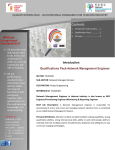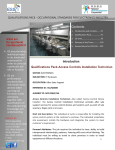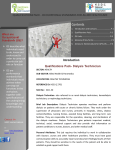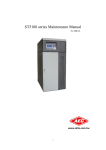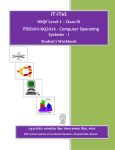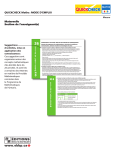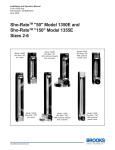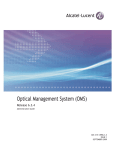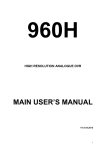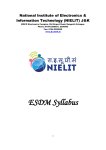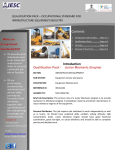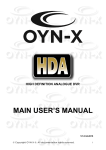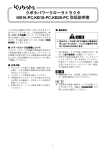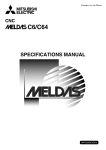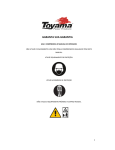Download Qualifications Pack – Network Management Engineer
Transcript
QUALIFICATIONS PACK - OCCUPATIONAL STANDARDS FOR TELECOM INDUSTRY Contents 1. Introduction and Contacts.....….….….….….…1 W h at a r e O c c u p at i o n al S t an d ar d s ( O S ) ? 2. Qualifications Pack……….…….......................2 3. Glossary of Key Terms.................................3 OS describe what individuals need to do, know and understand in order to carry out a particular job role or function OS are performance standards that individuals must achieve when carrying out functions in the workplace, together with specifications of the underpinning knowledge and understanding Contact Us: 2nd Floor, PLOT : 105,Sector - 44, GURGAON - 122003 T: 0124 - 4148029 E-mail: [email protected] 4. OS Units......................................................5 5. Assessment Criteria..................................36 Introduction Qualifications Pack-Network Management Engineer Attendant SECTOR: TELECOM SUB-SECTOR: Network Managed Services OCCUPATION: Project Engineering REFERENCE ID: TEL/Q6302 ALIGNED TO: NCO-2015/3114.1301 Network Management Engineer in telecom industry is also known as NOC Engineer/Provisioning Engineer/Monitoring & Reporting Engineer Brief Job Description: A Network Management Engineer is responsible for provisioning of end to end circuit and managing network elements from a Centralized server called Network Management System. Personal Attributes: Attention to detail, excellent problem-solving capabilities, strong quantitative abilities, strong interpersonal skills, ability to work with people, ability to multitask and track multiple projects simultaneously, dedication and willingness to stay current on changing technologies. Qualifications Pack for Network Management Engineer TEL/Q6302 Job Details Qualifications Pack Code Job Role Credits NSQF Sector Sub-sector Occupation Network Management Engineer TBD Version number 1.0 Telecom Network Managed Services Drafted on 02/05/2013 Last reviewed on 29/04/2015 Project Engineering Next review date 31/05/2017 NSQF Clearance on Job Role Role Description NSQF level Minimum Educational Qualifications* Maximum Educational Qualifications* Training Minimum Job Entry Age Experience Applicable National Occupational Standards (NOS) 20/07/2015 Network Management Engineer NOC Engineer, Monitoring & Reporting Enginneer, Provisioning Engineer A Network Management Engineer (NME) is responsible for provisioning end to end circuit, monitoring and reporting the health of network element from a centralized server 5 Diploma BE/B.Tech(CSE/ECE/EEE) L1 (SDH, DWDM), L2(Switching, Routing) Technologies, Basics of Linux, Java and Mysql 21 Years 0 – 4 Years of hands on experience in Networking (Click to open the below hyperlinks) Compulsory: 1. TEL/N6306(Provisioning of SDH equipment) 2. TEL/N6307(Provisioning of DWDM equipment) 3. TEL/N6308(Provisioning of L2 equipment) 4. TEL/N6309(Monitoring and Reporting the status of SDH, DWDM, L2 equipment) Optional: Not applicable Performance Criteria As described in the relevant OS units. 2 Qualifications Pack for Network Management Engineer Keywords /Terms Sector Sub-sector Occupation Function Job Role OS Performance Criteria NOS Qualifications Pack Code Qualifications Pack Unit Code Unit Title Description Knowledge and Understanding Organizational Context Technical Knowledge Core Skills or Generic Skills Description Sector is a conglomeration of different business operations having similar businesses and interests. It may also be defined as a distinct subset of the economy whose components share similar characteristics and interests. Sub-sector is derived from a further breakdown based on the characteristics and interests of its components. Occupation is a set of job roles, which perform similar/related set of functions in an industry. Function is an activity necessary for achieving the key purpose of the sector, occupation, or area of work, which can be carried out by a person or a group of persons. Functions are identified through functional analysis and form the basis of OS. Job role defines a unique set of functions that together form a unique employment opportunity in an organization. OS specify the standards of performance an individual must achieve when carrying out a function in the workplace, together with the knowledge and understanding they need to meet that standard consistently. Occupational Standards are applicable both in the Indian and global contexts. Performance Criteria are statements that together specify the standard of performance required when carrying out a task. NOS are Occupational Standards which apply uniquely in the Indian context. Qualifications Pack Code is a unique reference code that identifies a qualifications pack. Qualifications Pack comprises the set of OS, together with the educational, training and other criteria required to perform a job role. A Qualifications Pack is assigned a unique qualification pack code. Unit Code is a unique identifier for an Occupational Standard , which is denoted by an ‘N’. Unit Title gives a clear overall statement about what the incumbent should be able to do. Description gives a short summary of the unit content. This would be helpful to anyone searching on a database to verify that this is the appropriate OS they are looking for. Knowledge and Understanding are statements which together specify the technical, generic, professional and organizational specific knowledge that an individual needs in order to perform to the required standard. Organizational Context includes the way the organization is structured and how it operates, including the extent of operative knowledge managers have of their relevant areas of responsibility. Technical Knowledge is the specific knowledge needed to accomplish specific designated responsibilities. Core Skills or Generic Skills are a group of skills that are key to learning and working in today's world. These skills are typically needed in any work environment. In the context of the OS , these include communication related skills that are applicable to most job roles. 3 Acronyms Insert SSC logo height – 0.51”, width 2.84” Qualifications Pack for Network Managent Engineer Keywords /Terms Description NMS Network Management System EMS Element Management System L2 Layer 2, i.e. Data link layer standard of OSI architecture L3 Layer 3, i.e. Network layer standard of OSI architecture SDH Synchronous Digital Hierarchy DWDM Dense Wavelength Division Multiplexing NOC Network Operation Centre PDH Plesiochronous Digital Hierarchy NME Network Management Engineer GUI Graphic User Interface WTR Wait To Restore SHE Safety, Health & Environment OHS O&M Organizational Health & Safety Voltage Standing Wave Ratio, it is a measure of the reflected power on a transmission line. Operation & Maintenance LAN Local Area Network MAN Metropolitan Area Network WAN Wide Area Network RIP Routing Information Protocol OSPF Open Shortest Path First VCG Virtual Cotainer Group EoS Ethernet over SDH IGRP Interior Gateway Routing Protocol EDFA Erbium Doped Fiber Amplifier ROADM Reconfigurable Optical Add-Drop Multiplexer MDU Multiplexer Dimultiplexer Unit SFP Small Form Factor Pluggable DCN Data Communication Network VSWR Back to top… 4 TEL/N6306 Provisioning of SDH equipment ----------------------------------------------------------------------------------------------------------------------------- ---------- National Occupational Standard ----------------------------------------------------------------------------------------------------------------------------- ---------- Overview This unit is about carrying out end to end circuit provisioning of SDH equipment from a Centralized Server 1|P a ge TEL/N6306 National Occupational Standard Unit Code Unit Title (Task) Description Scope Provisioning of SDH equipment TEL /N6305 Provisioning of SDH equipment This unit provides standard guidelines for provisioning of SDH equipment from centralized Network management System installed in Network Operation Centre [NOC]. This unit/task covers the following: Launching Network Management System (NMS). Hierarchy of NMS, EMS, Nodes. End to end unprotected circuit provisioning. End to end protected circuit provisioning. Activation of circuit. Deactivation and Deletion of circuit. Report and record. Performance Criteria (PC) Element Performance Criteria Launch Network Management System (NMS) To be competent, the user/individual on the job must be able to: PC1. PC2. PC3. PC4. PC5. PC6. 2|P a ge install and uninstall of Management Server software using the installation guide. identify the required hardware and software to launch NMS as indicated by user manual. open NMS GUI by using appropriate software/browser following reference guide. provide valid username and password to access NMS. identify all relevant links in NMS window. open node view for basic provisioning and bringing up ports. TEL/N6306 Follow NMS, EMS and Nodes Hierarchy Provisioning of SDH equipment To be competent, the user/individual on the job must be able to: PC1. PC2. PC3. PC4. PC5. Provision end to end unprotected circuit. To be competent, the user/individual on the job must be able to: PC1. PC2. PC3. PC4. PC5. PC6. PC7. PC8. Provision end to end Protected circuit. launch topology view from NMS. select the end nodes for creating circuit. select appropriate parameters for circuit creation as mentioned in reference guide. identify Node name, Port, Time slot as indicated in provisioning reference guide. identify PDH, SDH, VCG circuit types. select and provision circuits from topology view as well as normal views receive successfully created circuit message in NMS. verify the new created circuit is showing at node level following the reference guide. To be competent, the user/individual on the job must be able to: PC1. PC2. PC3. PC4. PC5. PC6. PC7. 3|P a ge add Element Management System (EMS) to the NMS. launch EMS GUI from NMS. identify all Network Elements (Nodes) in the EMS. identify the network hierarchy matching in network view of NMS and EMS. identify that any configuration changes from NMS are reflected in nodes and vice versa. identify protected class of service menu in NMS GUI. identify revertive mode of protection in NMS. identify Wait To Restore (WTR) option. select appropriate path for creation of protected circuit following instructions in provisioning reference. identify right protection mechanism to be employed as per the guidelines. receive successfully created circuit message in NMS. verify the new created circuit is showing at node level following the reference guide. TEL/N6306 Activate circuit Provisioning of SDH equipment To be competent, the user/individual on the job must be able to: PC1. PC2. PC3. Deactivate and delete circuit To be competent, the user/individual on the job must be able to: PC1. PC2. PC3. PC4. PC5. Report and record filter the created circuit using guidelines. identify the circuit with activation status as pending. activate the circuit following instruction in reference guide. identify the circuit which requires deletion. deactivate the circuit following the reference guidelines. delete the circuit using steps as mentioned in reference guide. check if the deleted circuit is actually deleted from the circuit list. ensure the circuit deletion at node level by checking at the nodes. To be competent, the user/individual on the job must be able to: PC1. PC2. PC3. ensure all relevant parties (O&M, NOC team, other supervisor) are notified of the results SDH circuit provisioning. ensure that all newly created circuits with relevant parameters are updated in provisioning report format. ensure that records are available to all appropriate authorities to inspect. Knowledge and Understanding (K) The user/individual on the job needs to know and understand: A. Organizational Context KA1. risk and impact of not following defined procedures/work (Knowledge of the instructions. company / KA2. escalation matrix for reporting identified incidents, troubles and/or organization and emergencies e.g. system failures, fire and power failures. its processes) KA3. types of documentation in organization and importance of the same. KA4. B. Technical Knowledge records to be maintained and implication of non-maintenance of the same. The user/individual on the job needs to know and understand: KB1. KB2. KB3. KB4. KB5. KB6. KB7. KB8. KB9. KB10. 4|P a ge basic LINUX commands. basic Mysql and simple Java commands. TMF814 standards. application scenario of Network Management System. configuration of Server and Client. PDH and SDH technology. mapping and multiplexing technology of SDH. optical Add-Drop Multiplexers. cross-connects. basic equipment design and application. TEL/N6306 Provisioning of SDH equipment KB11. KB12. KB13. optical Fiber transmission. functions of attenuators. functionality of test equipment, line tester, Ethernet tester, VSWR meter, RF power meter, Optical meter etc. Skills (S) (Optional) A. Core Skills/ Generic Skills Writing Skills, The user/ individual on the job needs to know and understand how to: SA1. SA2. SA3. draft provisioning guide. write provisioning report format. record provisioning details in report format. Reading Skills The user/individual on the job needs to know and understand how to: SA4. SA5. read and interpret the exact provisioning requirement from provisioning order document. read and analyze the messages and prompt from the NMS system while provisioning. Oral Communication (Listening and Speaking skills) The user/individual on the job needs to know and understand how to: SA6. SA7. SA8. B. Professional Skills explain complex design and concepts in non-technical language. communicate with supervisor properly. provide advice and guidance to peers and juniors. Equipment operating skills The user/individual on the job needs to know and understand how to: SB1. SB2. SB3. SB4. configure server and client for Network management system. operate Network Management System server. operate Network Management System client. connect NMS server with the switch. Technical interpretation skills The user/individual on the job needs to know and understand how to: 5|P a ge TEL/N6306 Provisioning of SDH equipment SB5. SB6. analyze provisioning reports to identify the preventive actions to eliminate error in provisioning. interpret SDH, PDH test sets test results to localize faults and undertake appropriate steps to rectify the provisioning error. Decision Making The user/individual on the job needs to know and understand how to: SB7. SB8. SB9. decide if provisioning needs to be halted under critical circumstances and report to relevant authority. decide if any extra tolls are needed for convenient provisioning. decide if experts help is needed at any stage main activity to prevent escalation. Plan and Organize The user/individual on the job needs to know and understand how to: SB10. SB11. SB12. SB13. prioritize and execute tasks in high-pressure environment. multitask by handling multiple tasks and completing them successfully with due timeline. use and maintain resources efficiently and effectively. be flexible and accept changes in job requirements, schedules or work environments. Customer Centricity The user/individual on the job needs to know and understand how to: SB14. SB15. communicate with the customer professionally yet providing them relevant information. ask for any help or assistance if needed. Problem solving skills The user/individual on the job needs to know and understand how to: SB16. SB17. utilize appropriate tools and commands to resolve error prompt while provisioning following instruction guide. utilize appropriate communication channels to escalate unresolved problems to relevant personnel. Analytical Thinking The user/individual on the job needs to know and understand how to: 6|P a ge TEL/N6306 Provisioning of SDH equipment SB18. SB19. SB20. 7|P a ge interpret reports and numerical data in provisioning guide. think through to address complex problems. source technical information by researching enterprise website or manufacturer’s technical documentation. TEL/N6306 Provisioning of SDH equipment NOS Version Control NOS Code TEL/N6305 Credits NSQF TBD Industry Industry Sub-sector Version number 1.0 Telecom Drafted on 02/05/2013 Network Managed Services Last reviewed on 29/05/2015 Next review date 31/05/2017 Back to QP 8|P a ge TEL/N6307 Provisioning of DWDM equipment ----------------------------------------------------------------------------------------------------------------------------- ---------- National Occupational Standard ----------------------------------------------------------------------------------------------------------------------------- ---------- Overview This unit is about carrying out end to end circuit provisioning of DWDM network/equipment from a Centralized Server 1|P a ge National Occupational Standard TEL/N6307 Provisioning of DWDM equipment Unit Code TEL /N6306 Unit Title (Task) Description Provisioning of DWDM equipment Scope This unit/task covers the following: This unit provides standard guidelines for provisioning of DWDM equipment from Network management System installed in Network Operation Centre (NOC). Launching Network Management System (NMS). Hierarchy of NMS, EMS, Nodes. Provisioning DWDM amplifier. Provisioning MDU units. Provisioning RODAM. End to end unprotected and protected circuit provisioning. End to end protected and protected circuit provisioning. Activation of circuit. Deactivation and Deletion of circuit. Report and Record. Performance Criteria (PC) Element Performance Criteria Launch Network Management System (NMS) To be competent, the user/individual on the job must be able to: PC1. PC2. PC3. PC4. PC5. 2|P a ge install and uninstall of Management Server software using the installation guide. identify the required hardware and software to launch NMS as indicated by user manual. open NMS GUI by using appropriate software/browser following reference guide. provide valid username and password to access NMS. identify all relevant links in NMS window as indicated in reference guide. TEL/N6307 Follow NMS, EMS and Nodes Hierarchy Provisioning of DWDM equipment To be competent, the user/individual on the job must be able to: PC1. PC2. PC3. PC4. PC5. Provision DWDM Amplifiers To be competent, the user/individual on the job must be able to: PC1. PC2. PC3. PC4. PC5. PC6. Provision MDU units PC2. PC3. PC4. select the right cards based on even or odd channel multiplexing and based on the channel spacing. provision the correct DWDM SFPs in the MDU cards to ensure that cards would do multiplexing correctly. provision the express channels in the cards properly for pass through of other channels. ensure that the client side SFPs are correctly provisioned for the desired application. To be competent, the user/individual on the job must be able to: PC1. PC2. PC3. 3|P a ge provision the cards for RAMAN and EDFA amplifiers matching reference parameters. select the amplifier gain based on flat gain or customer gain. select the amplifier to be a pre-amplifier or post amplifier based in application for the DWDM networks. select the amplifier to be a pre-amplifier or post amplifier based on application for the DWDM network. ensure using the spectrometer the gain is as desired. ensure that Optical supervisory channel for DCN management also gets amplified as desired. To be competent, the user/individual on the job must be able to: PC1. Provision ROADM add Element Management System (EMS) to the NMS. launch EMS GUI from NMS. identify all Network Elements (Nodes) supporting DWDM in the EMS. identify the network hierarchy matching in network view of NMS and EMS identify that any configuration changes from NMS are reflected in Nodes and vice versa. ensure that correct ROADM is provisioned based on the application. provision degree of ROADM to ensure number of channels being configured. provision add and drop channels on the ROADM correctly. TEL/N6307 Provision end to end unprotected circuit. Provisioning of DWDM equipment To be competent, the user/individual on the job must be able to: PC1. PC2. PC3. PC4. PC5. PC6. Provision end to end Protected circuit. To be competent, the user/individual on the job must be able to: PC1. PC2. PC3. PC4. PC5. PC6. Activate circuit filter the created circuit using guidelines. activate the circuit if it is not in activated state following instruction in reference guide. To be competent, the user/individual on the job must be able to: PC1. PC2. PC3. PC4. PC5. 4|P a ge identify protected class of service menu in NMS GUI. identify revertive mode of protection in NMS. identify Wait To restore (WTR) option. select appropriate path for creation of protected circuit following instructions in provisioning reference. identify successfully created circuit message in NMS. verify the new created circuit is showing at node level following the reference guide. To be competent, the user/individual on the job must be able to: PC1. PC2. Deactivate and delete circuit launch topology view from NMS. select the end nodes for creating circuit. select appropriate parameters for circuit creation as mentioned in reference guide. identify Node name, Port, Time slot as indicated in provisioning reference. identify successfully created circuit message in NMS. verify the new created circuit is showing at node level following the reference guide. identify the circuit which requires deletion as mentioned in reference document. deactivate the circuit using the reference guidelines. delete the circuit using appropriate method. check if the deleted circuit is actually deleted from the circuit list. ensure the circuit deletion at node level by checking at the nodes. TEL/N6307 Report and Record Provisioning of DWDM equipment To be competent, the user/individual on the job must be able to: PC1. PC2. PC3. ensure all relevant parties (O&M, NOC team, other supervisor) are notified of the results SDH circuit provisioning. ensure that all newly created circuits with relevant parameters are updated in provisioning report format. ensure that records are available to all appropriate authorities to inspect. Knowledge and Understanding (K) A. Organizational Context (Knowledge of the company / organization and its processes) B. Technical Knowledge The user/individual on the job needs to know and understand: SB1. risk and impact of not following defined procedures/work instructions. SB2. escalation matrix for reporting identified incidents, troubles and/or emergencies e.g. system failures, fire and power failures. SB3. types of documentation in organization and importance of the same. SB4. records to be maintained and implication of non-maintenance of the same. The user/individual on the job needs to know and understand: KB1. KB2. KB3. KB4. KB5. KB6. KB7. KB8. KB9. KB10. KB11. KB12. KB13. KB14. KB15. KB16. KB17. KB18. 5|P a ge basic LINUX commands . basic Mysql and simple Java commands. TMF814 standards. application scenario of Network Management System. configuration of Server and Client. how the DWDM technology works. applications of DWDM. key components of DWDM systems. architecture of a DWDM network. key considerations related to the deployment of DWDM. optical Add-Drop Multiplexers. optical Cross-Connects. mapping and multiplexing technology of DWDM. optical Add-Drop Multiplexers. basic equipment design and application. optical Fiber transmission. functions of SFPs, attenuators. functionality of test equipment, line tester, Ethernet tester, VSWR meter, RF power meter, Optical meter etc. TEL/N6307 Provisioning of DWDM equipment Skills (S) (Optional) A. Core Skills/ Generic Skills Writing Skills, The user/ individual on the job needs to know and understand how to: SA1. SA2. SA3. draft provisioning guide. write provisioning report format. record provisioning details in report format. Reading Skills The user/individual on the job needs to know and understand how to: SA4. SA5. interpret the exact network element from provisioning request document. read and analyze the messages and prompt from the NMS system while provisioning. Oral Communication (Listening and Speaking skills) The user/individual on the job needs to know and understand how to: SA6. SA7. SA8. B. Professional Skills explain complex design and concepts in non-technical language. communicate with supervisor properly. provide advice and guidance to peers and juniors. Equipment operating skills The user/individual on the job needs to know and understand how to: SB1. SB2. SB3. SB4. configure Server and Client for Network management system. operate Network Management System Server. operate Network Management System Client. connect NMS server with the switch. Technical interpretation skills The user/individual on the job needs to know and understand how to: SB5. SB6. 6|P a ge analyze provisioning reports to identify the preventive actions to eliminate error in provisioning. interpret SDH, PDH test sets test results to localize faults and undertake appropriate steps to rectify the provisioning error. TEL/N6307 Provisioning of DWDM equipment Decision Making The user/individual on the job needs to know and understand how to: SB7. SB8. SB9. decide if provisioning needs to be halted under critical circumstances and report to relevant authority. decide if any extra tolls are needed for convenient provisioning. decide if experts help is needed at any stage main activity to prevent escalation. Plan and Organize The user/individual on the job needs to know and understand how to: SB10. SB11. SB12. SB13. prioritize and execute tasks in high-pressure environment. multitask by handling multiple tasks and completing them Successfully with due timeline. use and maintain resources efficiently and effectively. be flexible and accept changes in job requirements, schedules or work environments. Customer Centricity The user/individual on the job needs to know and understand how to: SB14. SB15. communicate with the customer professionally yet providing them relevant information. ask for any help or assistance if needed Problem solving skills The user/individual on the job needs to know and understand how to: SB16. SB10. utilize appropriate tools and commands to resolve error prompt while provisioning following instruction guide. utilize appropriate communication channels to escalate unresolved problems to relevant personnel. Analytical Thinking The user/individual on the job needs to know and understand how to: SB11. SB12. SB13. 7|P a ge interpret reports and numerical data in provisioning guide. think through to address complex problems. source technical information by researching enterprise website or manufacturer’s technical documentation. TEL/N6307 Provisioning of DWDM equipment NOS Version Control NOS Code TEL/N6306 Credits NSQF TBD Industry Industry Sub-sector Version number 1.0 Telecom Drafted on 02/05/2013 Network Managed Services Last reviewed on 29/04/2015 Next review date 31/05/2017 Back to QP 8|P a ge TEL/N6308 Provisioning of Layer 2 equipment ----------------------------------------------------------------------------------------------------------------------------- ---------- National Occupational Standard ----------------------------------------------------------------------------------------------------------------------------- ---------- Overview This unit is about carrying out end to end provisioning of end to end Ethernet Services using Layer2 (L2) devices from a Centralized Server 1|P a ge TEL/N6308 National Occupational Standard Unit Code Unit Title (Task) Description Scope Provisioning of Layer 2 equipment TEL / N6307 Provisioning of Ethernet services using Layer2 (L2) devices from Network Management Systems (NMS). This unit provides standard guidelines for provisioning of Ethernet services using Layer2 devices using Network management System (NMS) installed in Centralized Network Operation Centre (NOC). This unit/task covers the following: Launching Network Management System (NMS). Identifying Switch view of Network. Understanding point to point and point to multipoint. Provision Ethernet Services. Implementation of Quality of Service. Activation of service. Deactivation and Deletion of service. Report and Record. Performance Criteria (PC) Element Performance Criteria Launch Network Management System (NMS) To be competent, the user/individual on the job must be able to: PC1. PC2. PC3. PC4. PC5. 2|P a ge install and uninstall of Management Server software using the installation guide. identify the required hardware and software to launch NMS as indicated by user manual. open NMS GUI by using appropriate software/browser following reference guide. provide valid username and password to access NMS. identify all relevant links in NMS window as mentioned on reference guide. TEL/N6308 Identify switch view of Networks. Provisioning of Layer 2 equipment To be competent, the user/individual on the job must be able to: PC1. PC2. PC3. PC4. PC5. Understand Point to point and point to multipoint communication To be competent, the user/individual on the job must be able to: PC1. PC2. PC3. PC4. Provision Ethernet services. PC3. PC4. PC5. PC6. add Ethernet service from NMS GUI following the reference guide. select appropriate service and technology as mentioned in provisioning reference guide. select appropriate domain for Quality of Service requirement. identify and select appropriate OAM parameters as mentioned in the requirement document. create Service by selecting appropriate menu as mentioned in reference guide. receive successfully created message. To be competent, the user/individual on the job must be able to: PC1. PC2. PC3. PC4. 3|P a ge understand Ethernet traffic flow can be between two devices or from one device to many devices. identify Point to point service as Tunnel and ELINE service in provisioning guide. identify Point to multipoint service as bridging and ELAN service in provisioning guide. provision point to point service in a point to multipoint environment as mentioned in reference document. To be competent, the user/individual on the job must be able to: PC1. PC2. Implement Quality of Service launch topology view from NMS following reference guide. identify network switch view. identify the connecting links between the Ethernet devices. distinguish different links that might be present between two L2 devices. identify the characteristics of link types. understand the requirement for Quality of Service. provision Capacity distribution profile. identify per hop behavior profile. configure traffic conditioning profile. TEL/N6308 Activate circuit Provisioning of Layer 2 equipment To be competent, the user/individual on the job must be able to: PC1. PC2. Deactivate and delete circuit To be competent, the user/individual on the job must be able to: PC1. PC2. PC3. PC4. PC5. Report and record filter the created circuit using guidelines. activate the circuit if it is not in activated state following instruction in reference guide. identify the circuit which requires deletion. deactivate the circuit using the reference guidelines. delete the circuit using appropriate method. check if the deleted circuit is actually deleted from the circuit list. ensure the circuit deletion at node level by checking at the nodes. To be competent, the user/individual on the job must be able to: PC1. PC2. PC3. ensure all relevant parties (O&M, NOC team, other supervisor) are notified of the results of L2 service provisioning. ensure that all newly created circuits with relevant parameters are updated in provisioning report format. ensure that records are available to all appropriate authorities to inspect. Knowledge and Understanding (K) A. Organizational Context (Knowledge of the company / organization and its processes) The user/individual on the job needs to know and understand: KA1. KA2. KA3. KA4. 4|P a ge risk and impact of not following defined procedures/work instructions. escalation matrix for reporting identified incidents, troubles and/or emergencies e.g. system failures, fire and power failures. types of documentation in organization and importance of the same. records to be maintained and implication of non-maintenance of the same. TEL/N6308 B. Technical Knowledge Provisioning of Layer 2 equipment The user/individual on the job needs to know and understand: KB1. KB2. KB3. KB4. KB5. KB6. KB7. KB8. KB9. KB10. KB11. KB12. KB13. KB14. KB15. KB16. KB17. KB18. KB19. KB20. basic LINUX commands . basic Mysql and simple Java commands. TMF814 standards. application scenario of Network Management System. configuration of Server and Client. OSI architecture. LAN, MAN, WAN architecture. ethernet Networking ie. Half Duplex, Full Duplex, Physical and Data link layer Ethernet. core, Distribution and Access Layer architecture. ethernet media and connector requirement. layer 2 switching Technologies. internet Protocol- TCI/IP, ip addressing, subnetting. IP Routing protocols, ie. RIP, OSPF, IGRP. Virtual Container Group (VCG). VLAN concepts. WAN protocols. Ethernet over SDH (EoS) technology and implementation. basic equipment design and application. login cables (RJ45, RS232 and Hi –Speed USB) for different site equipment. functionality of Ethernet test equipment. Skills (S) (Optional) A. Core Skills/ Generic Skills Writing Skills, The user/ individual on the job needs to know and understand how to: SA1. SA2. SA3. draft provisioning guide. write provisioning report format. record provisioning details in report format. Reading Skills The user/individual on the job needs to know and understand how to: SA4. SA5. 5|P a ge read and interpret the exact provisioning requirement from provisioning order document. read and analyze the messages and prompt from the NMS system while provisioning. TEL/N6308 Provisioning of Layer 2 equipment Oral Communication (Listening and Speaking skills) The user/individual on the job needs to know and understand how to: SA6. SA7. SA8. B. Professional Skills explain complex design and concepts in non-technical language. communicate with supervisor properly. provide advice and guidance to peers and juniors. Equipment operating skills The user/individual on the job needs to know and understand how to: SB1. SB2. SB3. SB4. configure Server and Client for Network management system. operate Network Management System Server. operate Network Management System Client. connect NMS server with the switch and configure following instructions manual. Technical interpretation skills The user/individual on the job needs to know and understand how to: SB1. SB2. analyze provisioning reports to identify the preventive actions to eliminate error in provisioning. interpret SDH, PDH test sets test results to localize faults and undertake appropriate steps to rectify the provisioning error. Decision Making The user/individual on the job needs to know and understand how to: SB3. SB4. SB5. decide if provisioning needs to be halted under critical circumstances and report to relevant authority. decide if any extra tolls are needed for convenient provisioning. decide if experts help is needed at any stage main activity to prevent escalation. Plan and Organize The user/individual on the job needs to know and understand how to: SB6. SB7. 6|P a ge prioritize and execute tasks in high-pressure environment. multitask by handling multiple tasks and completing them successfully with due timeline. TEL/N6308 Provisioning of Layer 2 equipment SB8. SB9. use and maintain resources efficiently and effectively. be flexible and accept changes in job requirements, schedules or work environments. Customer Centricity The user/individual on the job needs to know and understand how to: SB10. SB11. communicate with the customer professionally yet providing them relevant information. ask for any help or assistance if needed. Problem solving skills The user/individual on the job needs to know and understand how to: . SB12. utilize appropriate tools and commands to resolve error prompt while provisioning following instruction guide. SB13. utilize appropriate communication channels to escalate unresolved problems to relevant personnel. Analytical Thinking The user/individual on the job needs to know and understand how to: SB14. SB15. SB16. 7|P a ge interpret reports, readings and numerical data as per troubleshooting guide. think through to address complex problems. source technical information by researching enterprise website or manufacturer’s technical documentation. TEL/N6308 Provisioning of Layer 2 equipment NOS Version Control NOS Code TEL/N6307 Credits NSQF TBD Industry Industry Sub-sector Version number 1.0 Telecom Drafted on 02/05/2013 Network Managed Services Last reviewed on 29/04/2015 Next review date 31/05/2017 Back to QP 8|P a ge TEL/N6309 Monitoring & Reporting the status of SDH, DWDM and L2 equipment ----------------------------------------------------------------------------------------------------------------------------- ---------- National Occupational Standard ----------------------------------------------------------------------------------------------------------------------------- ---------- Overview This unit is about monitoring the health of SDH, DWDM and Layer2 networks consisting of all active network elements elements from centralized Network Management System (NMS) and reporting the status to appropriate team for preventive maintenance and troubleshooting purposes. 1|P a ge National Occupational Standard TEL/N6309 Monitoring & Reporting the status of SDH, DWDM and L2 equipment Unit Code TEL /N6308 Unit Title (Task) Description Monitoring and Reporting the status of SDH, DWDM, L2 equipment from Network Management Systems [NMS]. This unit provides standard guidelines for monitoring network elements health and reporting the status to appropriate authority. Scope This unit/task covers the following: Implementing and supporting Monitoring activities Resolving actual or potential monitoring problems. Implementing rules, alerts and notifications for monitoring. Addressing queries in an accurate and timely manner. Generating required report in required format. Reviewing and analyzing reports. Submitting reports on time Enhancing quality of reporting. Performance Criteria (PC) Element Performance Criteria Implement and support monitoring activities To be competent, the user/individual on the job must be able to: PC1. PC2. PC3. PC4. PC5. PC6. PC7. 2|P a ge identify the required hardware and software to launch NMS as indicated by user manual. open NMS GUI by using appropriate software/browser following reference guide. provide valid username and password to access NMS for monitoring. identify all relevant links in NMS window for monitoring and reporting activities as indicated in reference guide. monitor the status of Synchronization Clock source in Network Element. observe Performance Management parameters in Network Elements. view network topology with all Network Elements with connectivity. TEL/N6309 Monitoring & Reporting the status of SDH, DWDM and L2 equipment Resolve monitoring problems To be competent, the user/individual on the job must be able to: PC1. PC2. PC3. PC4. Implement rules, alert, notifications for monitoring To be competent, the user/individual on the job must be able to: PC1. PC2. PC3. Address queries on time PC3. PC4. understand the queries and record in specified format. provide appropriate information as per observation and record the same. receive feedback if the information is rightly shared. revert back with additional information if required. To be competent, the user/individual on the job must be able to: PC1. PC2. PC3. PC4. PC5. PC6. PC7. PC8. PC9. PC10. PC11. 3|P a ge identify the critical parameters for network health. implement rules, alert and notifications to identify any deviations in network management system following guidelines. record the network deviation appropriately in specified format. To be competent, the user/individual on the job must be able to: PC1. PC2. Generate required report in required format identify monitoring disturbances. locate the root cause of the problem by referring guidelines. resolve the problem if within limit. report the problem to appropriate team as indicated by the guidelines document. generate circuit provisioning report as per guidelines. generate DCN report as per guidelines. generate Bandwidth utilization report as per guidelines. generate tunnel and Ethernet service report as per guidelines. generate performance monitoring report as per guidelines. generate fault status report as per guidelines. generate other customized reports as per guidelines. identify the format PDF/ XML/ HTML/DOC in which the report needs to be generated. generate individual report and bulk report. generate report based on different time frames as defined by the guidelines. gave the reports in order as defined in report format. TEL/N6309 Monitoring & Reporting the status of SDH, DWDM and L2 equipment Review and analyze report To be competent, the user/individual on the job must be able to: PC1. PC2. PC3. Submit report To be competent, the user/individual on the job must be able to: PC1. PC2. PC3. Enhance quality of report review generated report to verify correct generation. analyze changes performance in reports in order to make recommendations to appropriate team as indicated by the guidelines. identify the causes of potential bottlenecks after analysis of report as per the guidelines. ensure all relevant parties (O&M, NOC team, other supervisor) are notified for report submission. ensure that reports are sent in required format. ensure that reports are available to all appropriate authorities to inspect. To be competent, the user/individual on the job must be able to: PC1. PC2. identify the limitations of generated report to reveal relevant information. suggest the format for better generation of report to programming team. Knowledge and Understanding (K) A. Organizational Context (Knowledge of the company / organization and its processes) 4|P a ge The user/individual on the job needs to know and understand: KA1. KA2. KA3. KA4. risk and impact of not following defined procedures/work instructions. escalation matrix for reporting identified incidents, troubles and/or emergencies e.g. system failures, fire and power failures. types of documentation in organization and importance of the same. records to be maintained and implication of non-maintenance of the same. TEL/N6309 Monitoring & Reporting the status of SDH, DWDM and L2 equipment B. Technical Knowledge The user/individual on the job needs to know and understand: KB1. KB2. KB3. KB4. KB5. KB6. KB7. KB8. KB9. KB10. KB11. KB12. application scenario of Network Management System. architecture and Configuration of Server and Client. basics of SDH, DWDM, L2 Technology. implementation of SDH, DWDM, L2 technology in Network Management System. alarm Severity. managing and filtering alarms. optical Add-Drop Multiplexers. optical Cross-Connects. optical Add-Drop Multiplexers. cross-connects. optical Fiber transmission. electrical and optical cables and usage in appropriate environment. Skills (S) (Optional) Reading Skills The user/individual on the job needs to know and understand how to: SA1. SA2. interpret notifications, alert and messages from NMS. understand generated report from NMS. Oral Communication (Listening and Speaking skills) The user/individual on the job needs to know and understand how to: SA3. SA4. SA5. A. Professional Skills 5|P a ge explain complex design and concepts in non-technical language. communicate with supervisor properly. provide advice and guidance to peers and juniors. Equipment operating skills TEL/N6309 Monitoring & Reporting the status of SDH, DWDM and L2 equipment The user/individual on the job needs to know and understand how to: SB1. SB2. SB3. SB4. SB5. operate Windows and Linux/Unix System. configure Server and Client for Network management system. operate Network Management System Server. operate Network Management System Client. connect NMS server with the switch. Technical interpretation skills The user/individual on the job needs to know and understand how to: SB8. SB9. anticipate future problems from the alert and notifications as indicated by the reference guide. analyze reports to identify the preventive maintenance activities. Customer Centricity The user/individual on the job needs to know and understand how to: SB10. SB11. 6|P a ge communicate with the customer professionally yet providing them relevant information. ask for any help or assistance if needed. TEL/N6309 Monitoring & Reporting the status of SDH, DWDM and L2 equipment NOS Version Control NOS Code TEL/N6308 Credits NSQF Version number 1.0 Industry Telecom Drafted on 02/05/2013 Industry Sub-sector Network Managed Services Last reviewed on 29/04/2015 Next review date 31/05/2017 Back to QP 7|P a ge Your SSC Job Role Qualification Pack Sector Skill Council Qualification Pack for Network Management Engineer Network Management Engineer TEL/Q6302 : Telecom 1. Criteria for assessment for each Qualification Pack will be created by the Sector Skill Council. Each Performance Criteria (PC) will be assigned marks proportional to its importance in NOS. SSC will also lay down proportion of marks for Theory and Skills Practical for each PC. 2. The assessment for the theory part will be based on knowledge bank of questions created by the SSC. 3. Individual assessment agencies will create unique question papers for theory and skill practical part for each candidate at each examination/training center. 4. To pass the Qualification Pack , every trainee should score a minimum of 40% in every NOS and overall 50% pass percentage. 6. In case of successfully passing only certain number of NOS's, the trainee is eligible to take subsequent assessment on the balance NOS's to pass the Qualification Pack. Assessment Outcome Assessment Criteria Total Mark (400) 1 2 PC3. open NMS GUI by using appropriate software/browser following reference guide. PC4. provide valid username and password to access NMS. PC5. identify all relevant links in NMS window PC6. open node view for basic provisioning and bringing up ports. 3 1 2 3 1 0 1 1 2 1 1 2 PC1. add Element Management System (EMS) to the NMS. PC2. launch EMS GUI from NMS. PC3. identify all Network Elements (Nodes) in the EMS. 3 2 4 1 1 2 2 1 2 2 1 1 2 1 1 4 4 2 2 2 2 3 1 2 2 3 4 2 1 2 2 1 1 1 2 1 2 1 1 2 3 3 1 1 2 1 2 1 2 1 1 2 3 3 1 2 1 1 1 2 3 1 2 2 1 1 PC1. launch topology view from NMS. PC2. select the end nodes for creating circuit PC3. select appropriate parameters for circuit creation as mentioned in reference guide. Provision end to end unprotected PC4. identify Node name, Port, Time slot as indicated in provisioning reference guide. PC5. identify PDH, SDH, VCG circuit types. PC6.select and provision circuits from topology view as well as normal views PC7. receive successfully created circuit message in NMS. PC8. verify the new created circuit is showing at node level following the reference guide. 100 PC1. identify protected class of service menu in NMS GUI. PC2. identify revertive mode of protection in NMS PC3. identify Wait To Restore (WTR) option PC4. select appropriate path for creation of protected circuit following instructions in provisioning reference PC5. identify right protection mechanism to be employed as per the guidelines PC6. receive successfully created circuit message in NMS PC7. verify th enew created circuit is showing at node level following the reference guide PC1. filter the crated circuit using guidelines Activate Circuit PC2. identify the circuit with activation status as pending PC3. activate the circuit following instruction in reference guide Deactivate and delete circuit Report and Record TEL /N 6306 Launch Netwrok Management System(NMS) Follow NMS, EMS and Nodes HIerarchy Provision DWDM Amplifiers PC1. identify the circuit which requires deletion. PC2. deactivate the circuit following the reference guidelines . PC3. delete the circuit using steps as mentioned in reference guide PC4. check if the deleted circuit is actually deleted from the circuit list PC5. ensure the circuit deletion at node level bu checking at the nodes Provision end to end unprotected circuit Provision end to end Protected circuit. Activate circuit Deactivate and Delete circuit Report and Result TEL/N6307 Launch Network Management System(NMS). Understand Point to Point and Point to Multipoint Communication Provision Ethernet Services 1 1 0 1 1 1 0 0 1 1 PC1. install and uninstall of Management Server software using the installation guide. 3 1 2 PC2. identify the required hardware and software to launch NMS as indicated by user manual. 3 1 2 PC3. open NMS GUI by using appropriate software/browser following reference guide. PC4. provide valid username and password to access NMS. PC5. identify all relevant links in NMS window as indicated in reference guide. 3 1 2 1 0 1 2 1 1 PC1. add Element Management System (EMS) to the NMS. PC2. launch EMS GUI from NMS PC3. identify all Network Elements(Nodes) supporting DWDM in the EMS PC4. identify the network hierarchy matching in network view of NMS and EMS 2 2 2 2 1 1 1 1 1 1 1 1 PC5. identify that any configuration changes from NMS are reflected in Nodes and vice versa. 2 1 1 PC1. provision the cards for RAMAN and EDFA amplifiers matching reference parameters. PC2.select the amplifier gain based on flat gain or customer gain. 3 3 1 1 2 2 3 1 2 3 3 1 1 2 2 3 1 2 3 1 2 4 1 3 3 3 1 1 2 2 3 3 3 1 1 1 2 2 2 PC1. launch topology view from NMS. PC2. select the end nodes for creating circuit. PC3. select appropriate parameters for circuit creation as mentioned in reference guide. PC4. identify Node name, Port, Time slot as indicated in provisioning reference. PC5. identify successfully created circuit message in NMS. PC6. verify the new created circuit is showing at node level following the reference guide. 3 3 3 3 3 3 1 1 1 1 1 1 2 2 2 2 2 2 PC1. identify protected class of service menu in NMS GUI. PC2. identify revertive mode of protection in NMS. PC3. identify Wait To restore (WTR) option. PC4. select appropriate path for creation of protected circuit following instructions in provisioning reference. PC5. identify successfully created circuit message in NMS. PC6. verify the new created circuit is showing at node level following the reference guide. 1 1 1 2 1 1 0 0 0 1 0 0 1 1 1 1 1 1 PC1. filter the created circuit using guidelines. 2 1 1 PC2. activate the circuit if it is not in activated state following instruction in reference guide. 2 1 1 PC1. identify the circuit which requires deletion as mentioned in reference document. PC2. deactivate the circuit using the reference guidelines. PC3. delete the circuit using appropriate method. PC4. check if the deleted circuit is actually deleted from the circuit list. PC5.ensure the circuit deletion at node level by checking at the nodes. 1 1 1 1 1 0 0 0 0 0 1 1 1 1 1 2 1 1 1 1 1 1 0 0 PC1. install and uninstall of Management Server software using the installation guide. 3 1 2 PC2.identify the required hardware and software to launch NMS as indicated by user manual. PC3.open NMS GUI by using appropriate software/browser following reference guide. PC4. provide valid username and password to access NMS PC5. identisfy all relevant links in NMS window as mentioned on reference guide 3 2 1 2 1 1 0 1 2 1 1 1 2 2 2 2 1 1 1 1 0 0 1 1 1 2 1 PC1. understand Ethernet traffic flow can be between two devices or from one device to many devices. PC2. identify Point to point service as Tunnel and ELINE service in provisioning guide. PC3. identify Point to multipoint service as bridging and ELAN service in provisioning guide. PC4. provision point to point service in a point to multipoint environment as mentioned in reference document. 1 1 1 1 1 1 0 0 0 1 0 1 PC1. add Ethernet service from NMS GUI following the reference guide. 1 0 1 2 2 1 1 1 1 2 2 1 1 1 1 1 1 0 PC2. provision Capacity distribution profile. PC3. identify per hop behavior profile. PC4. configure traffic conditioning profile. 5 4 3 3 4 2 1 1 1 2 2 2 PC1. filter the created circuit using guidelines. 5 2 3 PC2. activate the circuit if it is not in activated state following instruction in reference guide. 5 2 3 PC1. identify the circuit which requires deletion. PC2. deactivate the circuit using the reference guidelines. PC3. delete the circuit using appropriate method. PC4. check if the deleted circuit is actually deleted from the circuit list. PC5. ensure the circuit deletion at node level by checking at the nodes. 5 3 3 3 3 1 1 1 1 1 4 2 2 2 2 5 4 1 5 3 4 2 1 1 3 3 3 2 2 2 1 1 1 3 3 3 3 2 2 2 2 1 1 1 1 PC1. identify monitoring disturbances. PC2. locate the root cause of the problem by referring guidelines. PC3. resolve the problem if within limit. PC4. report the problem to appropriate team as indicated by the guidelines documents. 4 3 3 2 2 1 1 1 2 2 2 1 PC1. identify the critical parameters for network health. PC2. implement rules, alert and notifications to identify any deviations in network management system following guidelines. PC3. record the network deviation appropriately in specified format. 4 2 2 5 4 4 2 1 2 PC1. understand the queries and record in specified format. PC2. provide appropriate information as per observation and record the same. PC3. receive feedback if the information is rightly shared. PC4. revert back with additional information if required. 1 1 1 1 1 1 1 1 1 1 0 0 3 3 3 3 3 3 3 2 2 2 2 2 2 2 2 2 2 2 2 1 1 1 1 1 1 1 1 1 1 0 1 1 1 PC1. review generated report to verify correct generation. PC2. analyze changes performance in reports in order to make recommendations to appropriate team as indicated by the guidelines. 1 1 0 4 4 0 PC3. identify the causes of potential bottlenecks after analysis of report as per the guidelines. 5 4 1 PC2. ensure that reports are sent in required format. PC3. ensure that reports are available to all appropriate authorities to inspect. 3 2 1 2 2 1 1 0 0 PC1. identify the limitations of generated report to reveal relevant information PC2. suggest the format for better generation of report to programming team. 1 2 1 2 0 0 PC3. select the amplifier to be a pre-amplifier or post amplifier based in application for the DWDM networks. PC4. select the amplifier to be a pre-amplifier or post amplifier based on application for the DWDM network. PC5.ensure using the spectrometer the gain is as desired. PC1.select the right cards based on even or odd channel multiplexing and based on the channel spacing. PC2. provision the correct DWDM SFPs in the MDU cards to ensure that cards would do multiplexing correctly. PC1. ensure that correct ROADM is provisioned based on the application. PC2. provision degree of ROADM to ensure number of channels being configured. PC3.provision add and drop channels on the ROADM correctly. 100 PC1. ensure all relevant parties (O&M, NOC team, other supervisor) are notified of the results SDH circuit provisioning. PC2. ensure that all newly created circuits with relevant parameters are updated in provisioning report format. PC3. ensure that records are available to all appropriate authorities to inspect. PC2. identify network switch view. PC3. identify the connecting links between the Ethernet devices. PC4. distinguish different links that might be present between two L2 devices PC5. identify the characteristics of link types. PC2. select appropriate service and technology as mentioned in provisioning reference guide. PC3. select appropriate domain for Quality of Service requirement. 100 PC1. understand the requirement for Quality of Service. Activate Circuit Deactivate Circuit Report and Record PC1. ensure all relevant parties (O&M, NOC team, other supervisor) are notified of the results of L2 service provisioning. PC2. ensure that all newly created circuits with relevant parameters are updated in provisioning report format. PC3. ensure that records are available to all appropriate authorities to inspect. PC1. identify the required hardware and software to launch NMS as indicated by user manual. TEL/N 6308 Implement and Support Monitoring Activities Resolve Monitoring Problems Implement rules, alert, notifications for monitoring Address queries on time Generate requires report in requires format Review and analyse and report PC2. open NMS GUI by using appropriate software/browser following reference guide. PC3. provide valid username and password to access NMS for monitoring. PC4. identify all relevant links in NMS window for monitoring and reporting activities as indicated in reference guide. PC5. monitor the status of Synchronization Clock source in Network Element. PC6. observe Performance Management parameters in Network Elements. PC7. view network topology with all Network Elements with connectivity. PC1. generate circuit provisioning report as per guidelines. PC2. generate DCN report as per guidelines. PC3. generate Bandwidth utilization report as per guidelines. PC4. generate tunnel and Ethernet service report as per guidelines. PC5. generate performance monitoring report as per guidelines. PC6. generate fault status report as per guidelines. PC7. generate other customized reports as per guidelines. PC8. identify the format PDF/ XML/ HTML/DOC in which the report needs to be generated. PC9. generate individual report and bulk report. PC10. generate report based on different time frames as defined by the guidelines PC11. gave the reports in order as defined in report format PC1. ensure all relevant parties (O&M, NOC team, other supervisor) are notified for report submission. Submit Report Enhanced Quality of Report 2 3 3 2 1 1 PC4. identify and select appropriate OAM parameters as mentioned in the requirement document. PC5. create Service by selecting appropriate menu as mentioned in reference guide. PC6. receive successfully created message. Implement Quality of Service 1 1 1 1 1 2 PC1.launch topology view from NMS following reference guide. Identify switch view of Networks 3 4 4 3 2 PC2. ensure that all newly created circuits with relevant parameters are updated in provisioning report format. PC3. ensure that records are available to all appropriate authorities to inspect. PC3. provision the express channels in the cards properly for pass through of other channels. PC4. ensure that the client side SFPs are correctly provisioned for the desired application. Provision ROADM 1 PC1. ensure all relevant parties (O&M, NOC team, other supervisor) are notified of the results SDH circuit provisioning. PC6. ensure that Optical supervisory channel for DCN management also gets amplified as desired. Provision MDU units Skills Practical 2 EMS. PC5. identify that any configuration changes from NMS are reflected in nodes and vice versa. Provision end to end Protected circuit Theory 3 (NMS, EMS and Nodes Hierarchy) PC4. identify the network hierarchy matching in network view of NMS and circuit) Out Of 3 PC1.install and uninstall of Management Server software using the installation guide. PC2.identify the required hardware and software to launch NMS as indicated by user manual. 1. TEL/N6305 Launch Network Management System 100




































